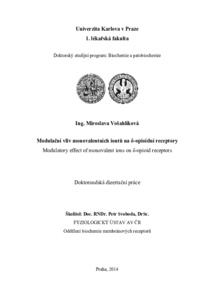Modulační vliv monovalentních iontů na δ-opioidní receptory
Modulatory effect of monovalent ions on δ-opioid receptors
dissertation thesis (DEFENDED)

View/
Permanent link
http://hdl.handle.net/20.500.11956/72973Identifiers
Study Information System: 149419
Collections
- Kvalifikační práce [4588]
Author
Advisor
Referee
Jakubík, Jan
Kršiak, Miloslav
Faculty / Institute
First Faculty of Medicine
Discipline
-
Department (external)
Information is unavailable
Date of defense
17. 6. 2014
Publisher
Univerzita Karlova, 1. lékařská fakultaLanguage
Czech
Grade
Pass
Keywords (Czech)
morfin, frontální mozková kůra, opioidní receptory, G proteiny, monovalentní ionty, plazmatická membrána, metody fluorescenční spektroskopieKeywords (English)
morphine, forebrain cortex, opioid receptors, G proteins, monovalent ions, plasma membrane, fluorescence spectroscopyPřesná role opioidních receptorů v drogové závislosti a také modulační mechanizmus, jakým jsou tyto receptory ovlivňovány monovalentními ionty, nejsou doposud zcela vysvětleny. Naše výsledky podporují názor, že mechanizmus závislosti na morfinu je primárně založen na desenzitizaci odpovědi μ- a δ-opioidních receptorů. Desenzitizace nastává již na úrovni funkční aktivity G proteinů. Dlouhodobé vystavení potkanů působení morfinu mělo za následek zvýšení počtu δ-opioidních receptorů a změnu jejich citlivosti vůči sodným iontům. Analýza inhibičního vlivu různých monovalentních iontů na vazbu agonisty v buněčné linii δ-OR-Gi1α (Cys351 -Ile351 )-HEK293 potvrdila preferenční citlivost δ-opioidního receptoru k sodným iontům. Podařilo se nám rozlišit vysoko- a nízkoafinní vazebná místa pro sodné ionty. Biofyzikální analýza interakce iontů lithia, sodíku, draslíku a cesia s plazmatickou membránou buněk HEK293 pomocí fluorescenčních technik ukázala na význam polárních skupin přítomných v povrchové vrstvě membrány. Právě do této oblasti je možné umístit vazebná místa s nízkou afinitou. Klíčová slova: morfin, frontální mozková kůra, opioidní receptory, G proteiny, monovalentní ionty, plazmatická membrána, metody fluorescenční spektroskopie.
The exact role of opioid receptors in drug addiction and modulatory mechanism of action of monovalent cations on these receptors are still not fully understood. Our results support the view that the mechanism of addiction to morphine is primarily based on desensitization of μ- and δ-opioid receptors. Desenzitization of agonist response proceeds already at the level of G protein functional activity. Long-term exposure of rats to morphine resulted in increase of number of δ-opioid receptors and change of their sensitivity to sodium ions. Analysis of the effect of different monovalent ions on agonist binding in δ-OR- Gi1α (Cys351 -Ile351 )-HEK293 cell line confirmed the preferential sensitivity of δ-opioid receptor to sodium ions. We have distinguished the high- and low-affinity Na+ sites. Biophysical analysis of interaction of lithium, sodium, potassium and cesium ions with plasma membranes isolated from HEK293 cells with the help of fluorescent probes indicated that monovalent ions interact, in low-affinity manner, with the polar, membrane-water interface of membrane bilayer. Key words: morphine, forebrain cortex, opioid receptors, G proteins, monovalent ions, plasma membrane, fluorescence spectroscopy.
